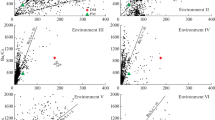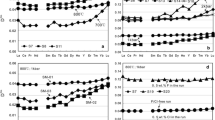Abstract
The partitioning of a number of trace elements (Ba, Nb, Zr, Y, REE, etc.) between orthopyroxene, garnet, and carbonate-silicate melt was experimentally studied using a belt apparatus at pressures of 3.5–4.2 GPa and temperatures of 1300–1500°C. The experimental products were investigated by electron microprobe analysis and laser ablation inductively coupled plasma mass spectrometry (LA-ICP-MS). The experimental melts varied from carbonatitic (∼5 wt % SiO2) at low temperatures (1300–1350°C) to kimberlitic compositions (30 wt % SiO2) at high temperatures (1500°C). The partition coefficients of most elements between orthopyroxene and melt (D Opx/L i ) and garnet and melt (D Grt/L i ) were almost independent of melt composition (temperature). The D Opx/L i values ranged from <0.01 for the most incompatible Ba and light REE to 0.02–0.08 for moderately incompatible Zr, Y, and heavy REE. The D Grt/L i values were approximately an order of magnitude higher, ∼0.07 for light REE, 0.7 for Y, and 1.5 for Yb. The character of D Grt/L i variations in the systems studied is in general similar to that established for silicate melts without volatile components. However, the differences in the behavior of moderately incompatible and compatible elements (e.g., light and heavy REE) in the experimental systems are less pronounced compared with CO2-free systems. Considering carbonate-silicate and silicate melts as possible agents of mantle metasomatism, it can be concluded that the former can efficiently transport heavy REE, and the latter have a greater affinity for Nb, Ba, and light REE. A characteristic feature of mantle rocks enriched by carbonate-silicate melts is high Ba/La ratio coupled with relatively weakly fractionated REE distribution patterns. It was shown that the high degrees of enrichment observed in natural kimberlites can be explained by a two-stage scenario, including a preliminary invasion of carbonate-silicate melt into depleted harzburgites in the lower parts of the lithosphere and subsequent very low degree melting.
Similar content being viewed by others
References
J. Adam and T. Green, “Experimentally Determined Partition Coefficients for Minor and Trace Elements in Peridotite Minerals and Carbonatitic Melt, and Their Relevance to Natural Carbonatites,” Eur. J. Mineral. 13, 815–827 (2001).
J. G. Arth, “Behavior of Trace Elements during Magmatic Processes—A Summary of Theoretical Models and Their Applications,” J. Res. US Geol. Surv. 4, 41–47 (1976).
M. G. Barth, S. F. Foley, and I. Horn, “Partial Melting in Archean Subduction Zones: Constraints from Experimentally Determined Trace Element Partition Coefficients between Eclogitic Minerals and Tonalitic Melts under Upper Mantle Conditions,” Precambrian Res. 113, 323–340 (2002).
S. L. Bennett, J. Blundy, and T. Elliott, “The Effect of Sodium and Titanium on Crystal-Melt Partitioning of Trace Elements,” Geochim. Cosmochim. Acta 68, 2335–2347 (2004).
J. Blundy and J. Dalton, “Experimental Comparison of Trace Element Partitioning between Clinopyroxene and Melt in Carbonate and Silicate Systems, and Implications for Mantle Metasomatism,” Contrib. Mineral. Petrol. 139, 356–371 (2000).
G. P. Brey, R. Weber, and K. G. Nickel, “Calibration of a Belt Apparatus to 1800°C and 6 GPa,” J. Geophys. Res. 95, 15603–15610 (1990).
C. Class, S. Goldstein, R. Altherr, and P. Bachelery, “The Process of Plume-Lithosphere Interactions in the Ocean Basins—The Case of Grand Comore,” J. Petrol. 39, 881–903 (1998).
J. A. Dalton and D. C. Presnall, “Carbonatitic Melts along the Solidus of Model Lherzolite in the System CaO-MgO-Al2O3-SiO2-CO2 from 3 to 7 GPa,” Contrib. Mineral. Petrol. 131, 123–135 (1998).
J. A. Dalton and B. J. Wood, “The Compositions of Primary Carbonate Melts and Their Evolution through Wallrock Reaction in the Mantle,” Earth Planet. Sci. Lett. 119, 511–525 (1993).
R. Doucelance, S. Escrig, M. Moreira, et al., “Pb-Sr-He Isotope and Trace Element Geochemistry of the Cape Verde Archipelago,” Geochim. Cosmochim. Acta. 67, 3717–3733 (2003).
D. S. Draper, D. Xirouchakis, and C. B. Agree, “Trace Element Partitioning between Garnet and Chondritic Melt from 5 to 9 GPa: Implications for the Onset of the Majorite Transition in the Martian Mantle,” Phys. Earth Planet. Int. 139, 149–169 (2003).
D. H. Eggler, “Kimberlites: How Do They Form?” in Kimberlites and Related Rocks, Ed. by J. Ross et al. (Blackwell, Melbourne, 1989), Vol. 1, pp. 489–504.
F. A. Frey, D. Clague, J. J. Mahoney, and J. M. Sinton, “Volcanism at the Edge of the Hawaiian Plume: Petrogenesis of Submarine Alkalic Lavas from the North Arch Volcanic Field,” J. Petrol. 41, 667–691 (2000).
M.-L. Frezzotti, J. L. R. Touret, and E.-R. Neumann, “Ephemeral Carbonate Melts in the Upper Mantle: Carbonate-Silicate Immiscibility in Microveins and Inclusions within Spinel Periodotite Xenoliths, La Gomera, Canary Islands,” Eur. J. Mineral. 14, 891–904 (2002).
H. Fujimaki, M. Tatsumoto, and K.-I. Aoki, “Partition Coefficients of Hf, Zr, and REE between Phenocrysts and Groundmasses,” J. Geophys. Res. 89, 662–672 (1984).
A. V. Gimis, G. P. Brey, and I. D. Ryabchikov, “Origin of Group IA Kimberlites: Fluid Saturated Melting Experiments at 45–55 kbar,” Earth Planet. Sci. Lett. 134, 283–296 (1995).
A. V. Girnis, V. K. Bulatov, and G. P. Brey, “Transition from Kimberlite to Carbonatite Melt under Mantle Parameters: An Experimental Study,” Petrologiya 13, 3–18 (2005) [Petrology 13, 1–15 (2005)].
D. H. Green and M. E. Wallace, “Mantle Metasomatism by Ephemeral Carbonatite Melts,” Nature 336, 459–462 (1988).
T. H. Green, J. D. Blundy, J. Adam, and G. M. Yaxley, “SIMS Determination of Trace Element Partition Coefficients between Garnet, Clinopyroxene and Hydrous Basaltic Liquids at 2–7.5 GPa and 1080–1200°C,” Lithos 53, 165–187 (2000).
R. H. Hunter and D. McKenzie, “The Equilibrium Geometry of Carbonate Melts in Rocks of Mantle Composition,” Earth Planet. Sci. Lett. 92, 347–356 (1989).
D. A. Ionov, C. Dupuy, S. Y. O’Reilly, et al., “Carbonated Peridotite Xenoliths from Spitsbergen: Implications for Trace Element Signature of Mantle Carbonate Metasomatism,” Earth Planet. Sci. Lett. 119, 283–297 (1993).
D. A. Ionov, S. Y. O’Reilly, Yu. S. Genshaft, and M. G. Kopylova, “Carbonate-Bearing Mantle Peridotite Xenoliths from Spitsbergen: Phase Relationships, Mineral Compositions and Trace-Element Residence,” Contrib. Mineral. Petrol. 125, 375–392 (1996).
A. J. Irving and F. A. Frey, “Distribution of Trace Elements between Garnet Megacrysts and Host Volcanic Liquids of Kimberlitic to Rhyolitic Composition,” Geochim. Cosmochim. Acta. 42, 771–787 (1978).
S. Keshav, A. Corgne, G. H. Gudfinnsson, et al., “Kimberlite Petrogenesis: Insights from Clinopyroxene-Melt Partitioning Experiments at 6 GPa in the CaO-MgO-Al2O3-SiO2-CO2 System,” Geochim. Cosmochim. Acta 69, 2829–2845 (2005).
S. Klemme and C. Daipe, “Trace-Element Partitioning between Apatite and Carbonatite Melt,” Am. Mineral. 88, 639–646 (2003).
S. Klemme, S. R. van der Laan, S. F. Foley, and D. Gunther, “Experimentally Determined Trace and Minor Element Partitioning between Clinopyroxene and Carbonatite Melt under Upper Mantle Conditions,” Earth Planet. Sci. Lett. 133, 439–448 (1995).
Y. Lahaye, D. Lambert, and S. Walters, “Ultraviolet Laser Sampling and High-Resolution Inductively Coupled Plasma Mass Spectrometry of NIST and BCR-2G Glass Reference Materials,” Geostand. Newslett. 21, 205–214 (1997).
C. C. Lundstrom, K. Hoernle, and J. Gill, “U-Series Disequilibria in Volcanic Rocks from the Canary Islands: Plume versus Lithospheric Melting,” Geochim. Cosmochim. Acta. 67, 4153–4177 (2003).
W. F. McDonough, “Constraints on the Composition of the Continental Lithospheric Mantle,” Earth Planet. Sci. Lett. 101, 1–18 (1990).
K. R. Moore and B. J. Wood, “The Transition from Carbonate to Silicate Melts in the CaO-MgO-SiO2-CO2 System,” J. Petrol. 39, 1943–1951 (1998).
I. A. Nicholls and K. L. Harris, “Experimental Rare Earth Element Partition Coefficients for Garnet, Clinopyroxene and Amphibole Coexisting with Andesitic and Basaltic Liquids,” Geochim. Cosmochim. Acta 44, 287–308 (1980).
K. G. Nickel and G. P. Brey, “Subsolidus Orthopyroxene-Clinopyroxene Systematics in the System CaO-MgO-SiO2 to 60 kb: A Re-Evaluation of the Regular Solution Model,” Contrib. Mineral. Petrol. 87, 35–42 (1984).
H. Palme and H. St. C. O’Neill, “Cosmochemical Estimates of Mantle Composition,” in Treatise on Geochemistry (Elsevier, Amsterdam, 2003), Vol. 2, pp. 1–38.
A. E. Ringwood, S. E. Kesson, W. Hibberson, and N. Ware, “Origin of Kimberlites and Related Magmas,” Earth Planet. Sci. Lett. 113, 521–538 (1992).
R. Rudnick, W. F. McDonough, and B. C. Chappell, “Carbonatite Metasomatism in the Northern Tanzanian Mantle,” Earth Planet. Sci. Lett. 114, 463–475 (1993).
I. D. Ryabchikov, “Geochemical Model of the Generation of Kimberlitic Melts,” Geochem. Int. 32, 103–111 (1995).
I. D. Ryabchikov, “Mechanisms and Conditions of Magma Formation in Mantle Plumes,” Petrologiya 11, 548–555 (2003) [Petrology 11, 496–503 (2003)].
I. D. Ryabchikov, G. Brey, L. N. Kogarko, and V. K. Bulatov, “Partial Melting of Carbonated Peridotite at 50 kbar,” Geokhimiya, No. 1, 3–9 (1989).
I. D. Ryabchikov, G. Brey, and V. K. Bulatov, “Carbonate Melts in Equilibrium with Mantle Peridotite at 50 kbar,” Petrologiya 1, 189–194 (1993).
C. B. Smith, J. J. Gurney, E. M. W. Skinner, et al., “Geochemical Character of Southern African Kimberlites: A New Approach Based on Isotopic Constraints,” Trans. Geol. Soc. S. Afr. 88, 267–280 (1985).
R. J. Sweeney, “Carbonatite Melt Compositions in the Earth’s Mantle,” Earth Planet. Sci. Lett. 128, 259–270 (1994).
R. J. Sweeney, D. H. Green, and S. H. Sie, “Trace and Minor Element Partitioning between Garnet and Amphibole and Carbonatitic Melt,” Earth Planet. Sci. Lett. 113, 1–14 (1992).
R. J. Sweeney, V. Prozesky, and W. Przybylowicz, “Selected Trace and Minor Element Partitioning between Peridotite Minerals and Carbonatite Melts at 18–46 kb Pressure,” Geochim. Cosmochim. Acta 59, 3671–3683 (1995).
K. M. Tainton and D. McKenzie, “The Generation of Kimberlites, Lamproites, and Their Source Rocks,” J. Petrol. 35, 787–817 (1994).
W. Van Westrenen, J. Blundy, and B. Wood, “Crystal-Chemical Controls on Trace Element Partitioning between Garnet and Anhydrous Silicate Melt,” Am. Mineral. 84, 838–847 (1999).
W. Van Westrenen, J. D. Blundy, and B. J. Wood, “Effect of Fe2+ on Garnet-Melt Trace Element Partitioning: Experiments in FCMAS and Quantification of Crystal-Chemical Controls in Natural Systems,” Lithos 53, 189–201 (2000).
R. Vannucci, P. Bottazzi, E. Wulff-Pedersen, and E.-R. Neumann, “Partitioning of REE, Y, Sr, Zr and Ti between Clinopyroxene and Silicate Melts in the Mantle under Palma (Canary Islands): Implications for the Nature of the Metasomatic Agents,” Earth Planet. Sci. Lett. 158, 39–51 (1998).
M. E. Wallace and D. H. Green, “An Experimental Determination of Primary Carbonatite Magma Composition,” Nature 335, 343–346 (1988).
R. K. Workman and S. R. Hart, “Major and Trace Element Composition of the Depleted MORB Mantle (DMM),” Earth Planet. Sci. Lett. 231, 53–72 (2005).
P. J. Wyllie, “Kimberlite Magmas from the System Peridotite-CO2-H2O,” in “Kimberlites, Diatremes, and Diamonds: Their Geology, Petrology and Geochemistry,” Ed. by F. R. Boyd and H. O. A. Meyer (Am. Geophys. Un., Washington, DC, 1979), pp. 319–329.
P. J. Wyllie, “Discussion of Recent Papers on Carbonated Peridotite, Bearing on Mantle Metasomatism and Magmatism,” Earth Planet. Sci. Lett. 82, 391–397 (1987).
P. J. Wyllie, “The Genesis of Kimberlites and Some Low-SiO2, High-Alkali Magmas,” in Kimberlites and Related Rocks, Ed. by J. Ross et al. (Blackwell, Melbourne, 1989), pp. 605–615.
G. M. Yaxley and D. H. Green, “Experimental Reconstruction of Sodic Dolomitic Carbonatite Melts from Metasomatised Lithosphere,” Contrib. Mineral. Petrol. 124, 359–369 (1996).
G. M. Yaxley, A. J. Crawford, and D. H. Green, “Evidence for Carbonatite Metasomatism in Spinel Peridotite Xenoliths from Western Victoria, Australia,” Earth Planet. Sci. Lett. 107, 305–317 (1991).
Author information
Authors and Affiliations
Additional information
Original Russian Text © A.V. Girnis, V.K. Bulatov, Y. Lahaye, G.P. Brey, 2006, published in Petrologiya, 2006, Vol. 14, No. 5, pp. 524–547.
Rights and permissions
About this article
Cite this article
Girnis, A.V., Bulatov, V.K., Lahaye, Y. et al. Partitioning of trace elements between carbonate-silicate melts and mantle minerals: Experiment and petrological consequences. Petrology 14, 492–514 (2006). https://doi.org/10.1134/S0869591106050055
Received:
Issue Date:
DOI: https://doi.org/10.1134/S0869591106050055




